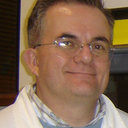Composition and biological activities of hogweed [Heracleum sphondylium L. subsp. ternatum (Velen.) Brummitt] essential oil and its main components octyl acetate and octyl butyrate.
Mots clés
Abstrait
The essential oil obtained from the fruits of hogweed (Heracleum sphondylium subsp. ternatum) growing in central Apennines (Italy) was analysed for chemical composition by gas chromatographic-flame ionisation detector (GC-FID) and gas chromatography-mass spectrometry (GC-MS). The oil was composed mainly of aliphatic esters (86.9-89.5%), among them octyl acetate (54.9-60.2%) and octyl butyrate (10.1-13.4%) were the most abundant. The oil and its two major esters, octyl acetate and octyl butyrate, were tested for in vitro biological activity, namely antibacterial, antioxidant and cytotoxic, by microdilution, DPPH (2,2-diphenyl-1-picrylhydrazyl), ABTS (2,2'-azino-bis(3-ethylbenzothiazoline-6-sulphonic acid)) and MTT (3-[4,5-dimethylthiazol-2-yl]-2,5 diphenyl tetrazolium bromide) assays. Worthy of mention was only the cytotoxic activity of the oil against two tumour cell lines, i.e. A375 (human malignant melanoma) and HCT116 (human colon carcinoma) cells, with IC50 values of 48.69 and 95.83 μg/mL, respectively; the major compound responsible for this effect was octyl butyrate which displayed IC50 values of 20.19 μg/mL (100.8 μM) and 55.35 μg/mL (276.3 μM) on the same cells, respectively.





